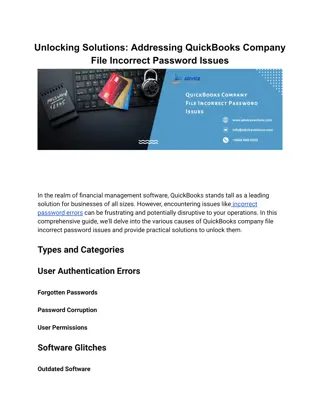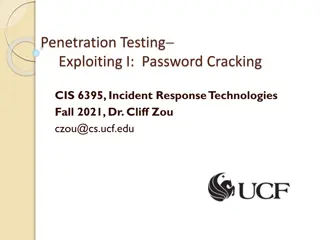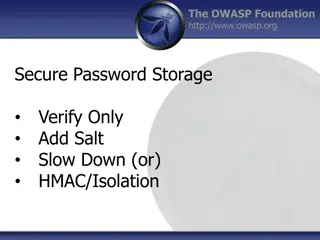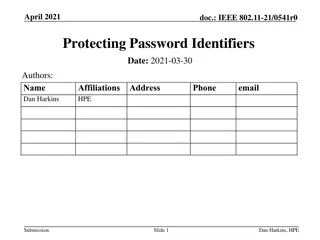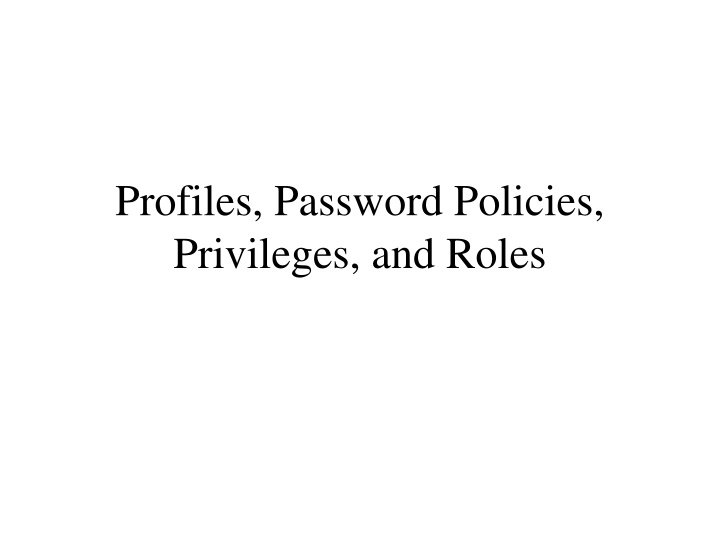
Enhancing Password Management Capabilities in MySQL
Discover how MySQL enables effective password management through features like: password expiration, reuse restrictions, verification, dual passwords, strength assessment, random generation, and more. Learn about setting expiration policies globally or individually to ensure maximum security.
Download Presentation

Please find below an Image/Link to download the presentation.
The content on the website is provided AS IS for your information and personal use only. It may not be sold, licensed, or shared on other websites without obtaining consent from the author. If you encounter any issues during the download, it is possible that the publisher has removed the file from their server.
You are allowed to download the files provided on this website for personal or commercial use, subject to the condition that they are used lawfully. All files are the property of their respective owners.
The content on the website is provided AS IS for your information and personal use only. It may not be sold, licensed, or shared on other websites without obtaining consent from the author.
E N D
Presentation Transcript
Profiles, Password Policies, Privileges, and Roles
Password Management supports the management capabilities: Password expiration, to require passwords to be changed periodically. Password reuse restrictions, to prevent old passwords from being chosen again. Password verification, to require that password changes also specify the current password to be replaced. Dual passwords, to enable clients to connect using either a primary or secondary password. MySQL following password-
Password Management Password strength assessment, to require strong passwords. Random password generation, as an alternative to requiring explicit administrator-specified literal passwords. Password failure tracking, to enable temporary account locking after too many consecutive incorrect-password login failures.
Password Expiration Policy MySQL enables database administrators to expire account passwords: - manually, - establish a policy for automatic password expiration. Expiration policy can be established globally, Individual accounts can be set to either defer to the global policy or override the global policy with specific per- account behavior.
Password Expiration Policy To expire an account password manually, use the ALTER USER statement: ALTER USER Kinan'@'localhost' PASSWORD EXPIRE; This operation marks the password expired in the corresponding row in the mysql.user system table.
Password Expiration Policy Password expiration according to policy is automatic and is based on password age, which for a given account is assessed from the date and time of its most recent password change. The mysql.user system table indicates for each account when its password was last changed, and the server automatically treats the password as expired at client connection time if its age is greater than its permitted lifetime. This works with no explicit manual password expiration.
Password Expiration Policy To establish automatic password-expiration policy globally, use the default_password_lifetime system variable. Its default value is 0, which disables automatic password expiration. If the value of default_password_lifetime is a positive integer N, it indicates the permitted password lifetime, such that passwords must be changed every N days.
Automatic Password-Expiration Policy Example: To establish a global policy that passwords have a lifetime of approximately six months, start the server with these lines in a server my.cnf file: [mysqld] default_password_lifetime=180
Password Expiration Policy To establish a global policy such that passwords never expire, set default_password_lifetime to 0: default_password_lifetime=0 default_password_lifetime can also be set and persisted at runtime: SET PERSIST default_password_lifetime = 180; SET PERSIST default_password_lifetime = 0; SET PERSIST sets a value for the running MySQL instance. It also saves the value to carry over to subsequent server restarts. To change the value for the running MySQL instance without having it carry over to subsequent restarts, use the GLOBAL keyword rather than PERSIST.
Password Expiration Policy The global password-expiration policy applies to all accounts that have not been set to override it. To establish policy for individual accounts, use the PASSWORD EXPIRE option of the CREATE USER andALTER USER statements.
CREATE USER and ALTER USER Require the password to be changed every 90 days: CREATE USER kinan'@'localhost' PASSWORD EXPIRE INTERVAL 90 DAY; ALTER USER ' kinan'@'localhost' PASSWORD EXPIRE INTERVAL 90 DAY; This expiration option overrides the global policy for all accounts named by the statement.
CREATE USER and ALTER USER Disable password expiration: CREATE USER 'kinan'@'localhost' PASSWORD EXPIRE NEVER; ALTER USER ' kinan'@'localhost' PASSWORD EXPIRE NEVER; This expiration option overrides the global policy for all accounts named by the statement.
Password Expiration Policy Defer to the global expiration policy for all accounts named by the statement: CREATE DEFAULT; ALTER DEFAULT; When a client successfully connects, the server determines whether the account password has expired: USER kinan'@'localhost' PASSWORD EXPIRE USER 'kinan'@'localhost' PASSWORD EXPIRE The server checks whether the password has been manually expired. Otherwise, the server checks whether the password age is greater than its permitted lifetime according to the automatic password expiration policy. If so, the server considers the password expired.
Password Expiration Policy If the password is expired (whether manually or automatically), the server either disconnects the client or restricts the operations permitted to it. Operations performed by a restricted client result in an error until the user establishes a new account password: ERROR 1820 (HY000): You must reset your password using ALTER USER statement before executing this statement.
Password Expiration Policy Although it is possible to reset an expired password by setting it to its current value, it is preferable, as a matter of good policy, to choose a different password. DBAs can enforce non-reuse by establishing an appropriate password-reuse policy.
Password Reuse Policy MySQL enables restrictions to be placed on reuse of previous passwords. Reuse restrictions can be established based on number of password changes, time elapsed, or both. Reuse policy can be established globally, and individual accounts can be set to either defer to the global policy or override the global policy with specific per-account behavior.
Password Reuse Policy The password history for an account consists of passwords it has been assigned in the past. MySQL can restrict new passwords from being chosen from this history:
Password Reuse Policy If an account is restricted on the basis of number of password changes, a new password cannot be chosen from a specified number of the most recent passwords. For example, if the minimum number of password changes is set to 3, a new password cannot be the same as any of the most recent 3 passwords. SET PERSIST password_history = 3;
Password Reuse Policy If an account is restricted based on time elapsed, a new password cannot be chosen from passwords in the history that are newer than a specified number of days. For example, if the password reuse interval is set to 60, a new password must not be among those previously chosen within the last 60 days. SET PERSIST password_reuse_interval = 60;
Password Reuse Policy The empty password does not count in the password history and is subject to reuse at any time. To establish password-reuse policy globally, use the password_history and password_reuse_interval system variables. Examples: To prohibit reusing any of the last 6 passwords or passwords newer than 365 days, put these lines in the server my.cnf file: password_history=6 password_reuse_interval=365
Password Reuse Policy To set and persist the variables at runtime, use statements like this: SET PERSIST password_history = 6; SET PERSIST password_reuse_interval = 365; SET PERSIST sets a value for the running MySQL instance. It also saves the value to carry over to subsequent server restarts. To change the value for the running MySQL instance without having it carry over to subsequent restarts, use the GLOBALkeyword rather than PERSIST.
Password Reuse Policy The global password-reuse policy applies to all accounts that have not been set to override it. To establish policy for individual accounts, use the PASSWORD HISTORY and PASSWORD REUSE INTERVAL options of the CREATE USER and ALTER USER statements.
Password Reuse Policy Example account-specific statements Require a minimum of 5 password changes before permitting reuse: CREATE USER kinan'@'localhost' PASSWORD HISTORY 5; ALTER USER ' kinan'@'localhost' PASSWORD HISTORY 5; This history-length option overrides the global policy for all accounts named by the statement.
Password Reuse Policy Require a minimum of 365 days elapsed before permitting reuse: CREATE USER kinan'@'localhost' PASSWORD REUSE INTERVAL 365 DAY; ALTER USER kinan'@'localhost' PASSWORD REUSE INTERVAL 365 DAY; This time-elapsed option overrides the global policy for all accounts named by the statement.
Password Reuse Policy To combine both types of reuse restrictions, use PASSWORD HISTORY and PASSWORD REUSE INTERVAL together: CREATE USER kinan'@'localhost , PASSWORD HISTORY 5, PASSWORD REUSE INTERVAL 365 DAY; ALTER USER kinan'@'localhost , PASSWORD HISTORY 5, PASSWORD REUSE INTERVAL 365 DAY; These options override both global policy reuse restrictions for all accounts named by the statement.
Password Verification-Required Policy Require that attempts to change an account password be verified by specifying the current password to be replaced. This enables DBAs to prevent users from changing a password without proving that they know the current password. Such changes could otherwise occur, for example, if one user walks away from a terminal session temporarily without logging out, and a malicious user uses the session to change the original user's MySQL password. This can have unfortunate consequences:
Password Verification-Required Policy The original user becomes unable to access MySQL until the account password administrator. is reset by an Until the password reset occurs, the malicious user can access MySQL with the benign user's changed credentials.
Password Verification-Required Policy Password-verification policy can be established globally, and individual accounts can be set to either defer to the global policy or override the global policy with specific per- account behavior.
Password Verification-Required Policy For each account, its mysql.user row indicates whether there is an account-specific setting requiring verification of the current password for password change attempts. The setting is established by the PASSWORD REQUIRE option of the CREATE USER and ALTER USER statements.
Password Verification-Required Policy If the account setting is PASSWORD REQUIRE CURRENT, password changes must specify the current password. If the account setting is PASSWORD REQUIRE CURRENT OPTIONAL, password changes may but need not specify the current password. If the account setting is PASSWORD REQUIRE CURRENT DEFAULT, the password_require_current system variable determines the verification-required policy for the account.
Password Verification-Required Policy If password_require_current changes must specify the current password. is enabled, password If password_require_current changes may but need not specify the current password. is disabled, password In other words, if the account setting is not PASSWORD REQUIRE CURRENT DEFAULT, the account setting takes precedence over the global policy established by the password_require_current system variable. Otherwise, the account password_require_current setting. defers to the
Password Verification-Required Policy By default, password password_require_current is disabled and accounts created with no PASSWORD REQUIRE option default to PASSWORD DEFAULT. verification is optional: REQUIRE CURRENT Privileged users can change any account password without specifying the current password, regardless of the verification-required policy. A privileged user is one who has the global CREATE USER privilege or the UPDATE privilege for the mysql system database.
Password Verification-Required Policy To establish password-verification policy globally, use the password_require_current system variable. Its default value is OFF, so it is not required that account password changes password. specify the current To set and persist password_require_current at runtime, use a statement such as one of these: SET PERSIST password_require_current = ON; SET PERSIST password_require_current = OFF;
Password Verification-Required Policy The global password verification-required policy applies to all accounts that have not been set to override it. To establish policy for individual accounts, use the PASSWORD REQUIRE options of the CREATE USER and ALTER USER statements. See CREATE USER Statement, and ALTER USER Statement.
Password Verification-Required Policy Example account-specific statements: Require that password changes specify the current password: CREATE USER Kinan'@'localhost' PASSWORD REQUIRE CURRENT; ALTER USER Kinan'@'localhost' REQUIRE CURRENT; This verification option overrides the global policy for all accounts named by the statement. PASSWORD
Password Verification-Required Policy Do not require that password changes specify the current password (the current password may but need not be given): CREATE REQUIRE CURRENT OPTIONAL; ALTER USER REQUIRE CURRENT OPTIONAL; This verification option overrides the global policy for all accounts named by the statement. USER kinan'@'localhost' PASSWORD kinan'@'localhost' PASSWORD
Password Verification-Required Policy Defer to the global password verification- required policy for all accounts named by the statement: CREATE USER kinan'@'localhost' PASSWORD REQUIRE CURRENT DEFAULT; ALTER USER kinan'@'localhost' PASSWORD REQUIRE CURRENT DEFAULT;
Dual Password Support User accounts are permitted to have dual passwords, designated as primary and secondary passwords. Dual-password capability makes it possible to seamlessly perform credential changes in scenarios like this: A system has a large number of MySQL servers, possibly involving replication. Multiple applications connect to different MySQL servers. Periodic credential changes must be made to the account or accounts used by the applications to connect to the servers.
Dual Password Support Consider how a credential change must be performed in the preceding type of scenario when an account is permitted only a single password. In this case, there must be close cooperation in the timing of when the account password change is made and propagated throughout all servers, and when all applications that use the account are updated to use the new password. This process may involve downtime during which servers or applications are unavailable.
Dual Password Support With dual passwords, credential changes can be made more easily, in phases, without requiring close cooperation, and without downtime. For each affected account, establish a new primary password on the servers, retaining the current password as the secondary password. This enables servers to recognize either the primary or secondary password for each account, while applications can continue to connect to the servers using the same password as previously (which is now the secondary password).
Dual Password Support After the password change has propagated to all servers, modify applications that use any affected account to connect using the account primary password. After all applications have been migrated from the secondary passwords to the primary passwords, the secondary passwords are no longer needed and can be discarded. After this change has propagated to all servers, only the primary password for each account can be used to connect. The credential change is now complete.
Dual Password Support MySQL implements dual-password capability with syntax that saves and discards secondary passwords: The RETAIN CURRENT PASSWORD clause for the ALTER USER and SET PASSWORD statements saves an account current password as its secondary password when you assign a new primary password. The DISCARD OLD PASSWORD clause for ALTER USER discards an account secondary password, leaving only the primary password.
Dual Password Support Example Suppose credential-change scenario, an account named kinan'@ localhost' is used by applications to connect to servers, and that the account password is to be changed 'password_b'. that, for the previously described from 'password_a' to
Dual Password Support On each server that is not a replica, establish 'password_b' as the new appuser1 primary password, retaining the current password as the secondary password: ALTER USER kinan'@ localhost , IDENTIFIED BY 'password_b , RETAIN CURRENT PASSWORD; Wait for the password change to replicate throughout the system to all replicas. Modify each application that uses the appuser1 account so that it connects to the servers using a password of 'password_b' rather than 'password_a'.
Dual Password Support At this point, the secondary password is no longer needed. On each server that is not a replica, discard the secondary password: ALTER USER kinan'@ localhost , DISCARD OLD PASSWORD; After the discard-password change has replicated to all replicas, the credential change is complete.
Dual Password Support RETAIN CURRENT PASSWORD retains an account current password as its secondary password, replacing any existing secondary password. The new password becomes the primary password, but clients can use the account to connect to the server using either the primary or secondary password. (Exception: If the new password specified by the ALTER USER or SET PASSWORD statement is empty, the secondary password becomes empty as well, even if RETAIN CURRENT PASSWORD is given.) If you specify RETAIN CURRENT PASSWORD for an account that has an empty primary password, the statement fails.
Dual Password Support If an account has a secondary password and you change its primary password without specifying RETAIN CURRENT PASSWORD, the secondary password remains unchanged. For ALTER USER, if you change the authentication plugin assigned to the account, the secondary password is discarded. If you change the authentication plugin and also specify RETAIN CURRENT PASSWORD, the statement fails. For ALTER USER, DISCARD OLD PASSWORD discards the secondary password, if one exists. The account retains only its primary password, and clients can use the account to connect to the server only with the primary password.
Dual Password Support Statements that modify secondary passwords require these privileges: The APPLICATION_PASSWORD_ADMIN privilege is required to use the RETAIN CURRENT PASSWORD or DISCARD OLD PASSWORD clause for ALTER USER and SET PASSWORD statements that apply to your own account. The privilege is required to manipulate your own secondary password because most users require only one password. If an account is to be permitted to manipulate secondary passwords for all accounts, it should be granted the CREATE USER privilege APPLICATION_PASSWORD_ADMIN. rather than
Random Password Generation The CREATE USER, ALTER USER, and SET PASSWORD statements have the capability of generating random passwords for user accounts, as an alternative to requiring specified literal passwords. explicit administrator- By default, generated random passwords have a length of 20 characters. This length is controlled by the generated_random_password_length variable, which has a range from 5 to 255. system
Random Password Generation CREATE USER 'u1'@'localhost' IDENTIFIED BY RANDOM PASSWORD, 'u2'@'%.example.com' IDENTIFIED PASSWORD, 'u3'@'%.org' IDENTIFIED BY RANDOM PASSWORD; BY RANDOM ALTER USER 'u1'@'localhost' IDENTIFIED BY RANDOM PASSWORD, 'u2'@'%.example.com' IDENTIFIED PASSWORD; BY RANDOM SET PASSWORD FOR 'u3'@'%.org' TO RANDOM;


